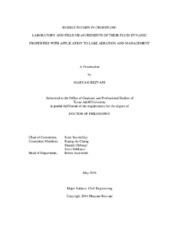| dc.description.abstract | This dissertation presents laboratory experiments of bubble plumes in crossflows and field measurements in managed lakes aerated by bubble plumes to better understand the behavior of bubble plumes in natural environments. The laboratory experiments were conducted to investigate the detailed time-average and turbulent fluctuating velocity field in the wake region behind the bubble column and above the separation height, at which fluid entrained at the base of the plume separates from the bubbles. These measurements are important for developing predictive models for bubble plume dynamics and for quantifying their mixing characteristics. Two field campaigns, at Carvins Cove in Virginia and at Lake Hallwil in Switzerland, were conducted to measure the detailed bottom boundary currents and oxygen exchange across the sediment-water interface for different diffuser operations. These lakes have different bubble plume diffuser types, and they span a range of shape, bathymetry, and environmental forcing. These field data are useful to elucidate the physical mechanisms by which currents resulting from both natural forcing (e.g., seiches) and artificial forcing (e.g., bubble plumes) affect oxygen uptake at the sediment-water interface, with the ultimate goal of better management of aeration systems in drinking water reservoirs.
Experimental techniques applied in the laboratory experiments include Particle Image Velocimetry (PIV) and Planar Laser Induced Fluorescence (PLIF). Crossflows were generated in two ways: by towing the source and by forcing a recirculation current. A combination of field equipment was used in the field campaigns, including a microprofiler for temperature and oxygen; point and profiling acoustic Doppler velocimeter (ADV); thermistor chains; conductivity, temperature, and depth (CTD) profiles; and a meteorological station. During the field experiments, the bubble plume flow rate was varied to produce different dynamic and chemical conditions in the lakes.
The laboratory experiments present a cohesive view of the flow dynamics in the wake of a bubble plume in crossflow. Using the forced and towed plume validates the analogy of the towed plume to that of the real current. The observations showed that no secondary bubble plume forms above the separation height, but rather the bubble column becomes a continuous source of vertical momentum to the wake region. The resulting vertical velocities impart a rising frame of reference on the separated plume so that its trajectory scales like a buoyant jet despite the absence of buoyancy in the separated fluid. Maximum values of the Reynolds stresses and mixing occur at the base of the separated plumes, and the bubble column elevates both the turbulence intensity and the kinetic energy throughout the wake region.
The in situ field measurements provide insight into the role of aeration bubble plumes on the oxygen dynamics at the sediment-water interface. Detailed, simultaneous measurements of turbulence and oxygen uptake in the bottom boundary layer allowed the direct validation of boundary exchange models. The measurements also showed that unsteady operation of the bubble plume results in generation of basin-scale internal waves that drive measurable currents in the bottom boundary layer. Moreover, measurements showed that it is the oxygen concentration outside the diffusive boundary layers that is the dominant mechanism for controlling the uptake at the sediment-water interface. | en |


